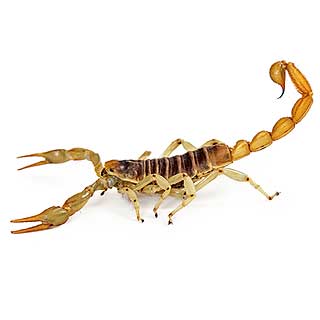Scorpions

Scorpions are found in Arkansas, but the striped bark scorpion, is the only scorpion species native to the state. It is the most widely distributed scorpion species in the United States, having been recorded from Missouri, Arkansas, and Louisiana west to eastern Colorado and New Mexico and south to northeastern Mexico.The front body region, which bears the yellowish-brown pincers and legs below, has a somewhat triangular median dark spot on top pointing backward and extending beyond the eyes. The wide body region that follows has a distinctive pair of broad, dark, longitudinal bands on top. The tip of the stinger is a darker brown or black. Adults grow to about 2½” long.
Striped bark scorpions often live under loose bark, rocks, or logs, as well as in wood piles, crumbling foundations, and similar sheltered places during the day. Arkansas scorpions tend to roam considerably during April, May, and early June, and they commonly enter houses, where they are often found in attics. Striped bark scorpions prey primarily on spiders and insects.
Scorpion stings often occur when people turn over wood or rocks with bare hands. The venom of the striped bark scorpion is of low toxicity to humans, and most stings are of minor medical importance. The usual symptoms are immediate sharp pain and local swelling. Severe allergic reactions and death are uncommon with striped bark scorpion stings.
